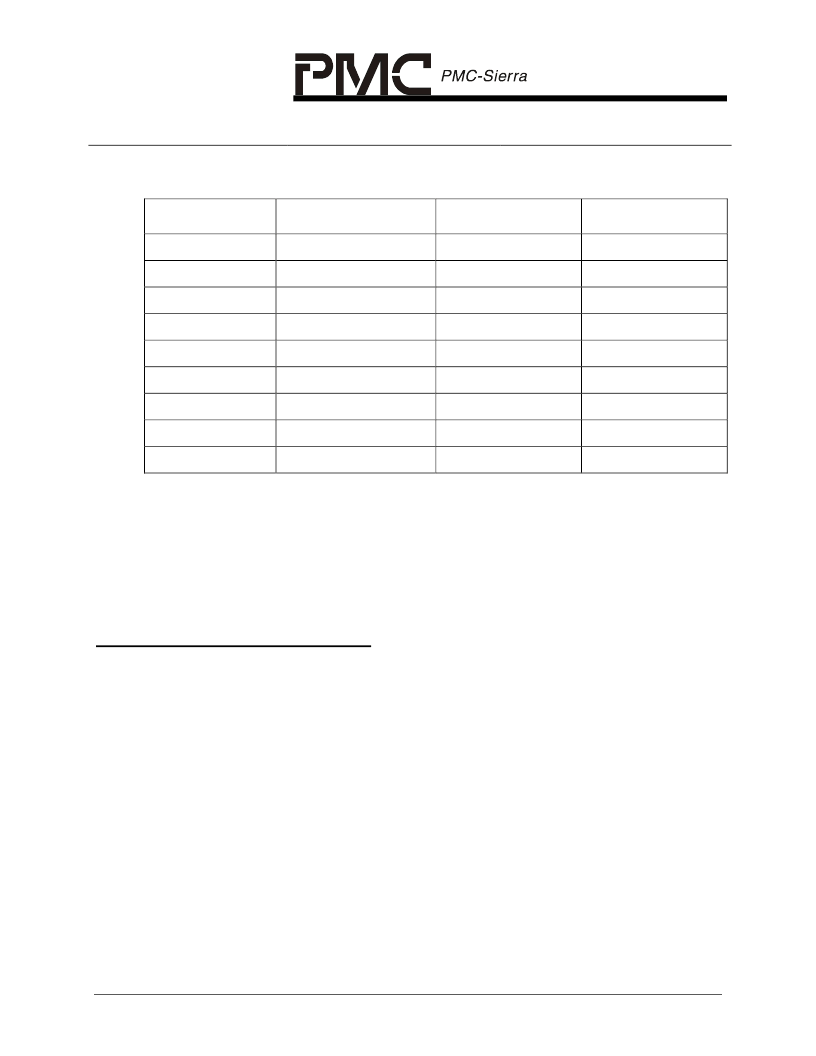- 您現(xiàn)在的位置:買賣IC網(wǎng) > PDF目錄378056 > PM8315-PI (PMC-SIERRA INC) Ultraframer DS3/E3/DS2/E2/DS1/E1/DS0 PDF資料下載
參數(shù)資料
| 型號: | PM8315-PI |
| 廠商: | PMC-SIERRA INC |
| 元件分類: | 數(shù)字傳輸電路 |
| 英文描述: | Ultraframer DS3/E3/DS2/E2/DS1/E1/DS0 |
| 中文描述: | DATACOM, FRAMER, PBGA324 |
| 封裝: | 23 X 23 MM, 2.33 MM HEIGHT, PLASTIC, BGA-324 |
| 文件頁數(shù): | 133/329頁 |
| 文件大小: | 3024K |
| 代理商: | PM8315-PI |
第1頁第2頁第3頁第4頁第5頁第6頁第7頁第8頁第9頁第10頁第11頁第12頁第13頁第14頁第15頁第16頁第17頁第18頁第19頁第20頁第21頁第22頁第23頁第24頁第25頁第26頁第27頁第28頁第29頁第30頁第31頁第32頁第33頁第34頁第35頁第36頁第37頁第38頁第39頁第40頁第41頁第42頁第43頁第44頁第45頁第46頁第47頁第48頁第49頁第50頁第51頁第52頁第53頁第54頁第55頁第56頁第57頁第58頁第59頁第60頁第61頁第62頁第63頁第64頁第65頁第66頁第67頁第68頁第69頁第70頁第71頁第72頁第73頁第74頁第75頁第76頁第77頁第78頁第79頁第80頁第81頁第82頁第83頁第84頁第85頁第86頁第87頁第88頁第89頁第90頁第91頁第92頁第93頁第94頁第95頁第96頁第97頁第98頁第99頁第100頁第101頁第102頁第103頁第104頁第105頁第106頁第107頁第108頁第109頁第110頁第111頁第112頁第113頁第114頁第115頁第116頁第117頁第118頁第119頁第120頁第121頁第122頁第123頁第124頁第125頁第126頁第127頁第128頁第129頁第130頁第131頁第132頁當(dāng)前第133頁第134頁第135頁第136頁第137頁第138頁第139頁第140頁第141頁第142頁第143頁第144頁第145頁第146頁第147頁第148頁第149頁第150頁第151頁第152頁第153頁第154頁第155頁第156頁第157頁第158頁第159頁第160頁第161頁第162頁第163頁第164頁第165頁第166頁第167頁第168頁第169頁第170頁第171頁第172頁第173頁第174頁第175頁第176頁第177頁第178頁第179頁第180頁第181頁第182頁第183頁第184頁第185頁第186頁第187頁第188頁第189頁第190頁第191頁第192頁第193頁第194頁第195頁第196頁第197頁第198頁第199頁第200頁第201頁第202頁第203頁第204頁第205頁第206頁第207頁第208頁第209頁第210頁第211頁第212頁第213頁第214頁第215頁第216頁第217頁第218頁第219頁第220頁第221頁第222頁第223頁第224頁第225頁第226頁第227頁第228頁第229頁第230頁第231頁第232頁第233頁第234頁第235頁第236頁第237頁第238頁第239頁第240頁第241頁第242頁第243頁第244頁第245頁第246頁第247頁第248頁第249頁第250頁第251頁第252頁第253頁第254頁第255頁第256頁第257頁第258頁第259頁第260頁第261頁第262頁第263頁第264頁第265頁第266頁第267頁第268頁第269頁第270頁第271頁第272頁第273頁第274頁第275頁第276頁第277頁第278頁第279頁第280頁第281頁第282頁第283頁第284頁第285頁第286頁第287頁第288頁第289頁第290頁第291頁第292頁第293頁第294頁第295頁第296頁第297頁第298頁第299頁第300頁第301頁第302頁第303頁第304頁第305頁第306頁第307頁第308頁第309頁第310頁第311頁第312頁第313頁第314頁第315頁第316頁第317頁第318頁第319頁第320頁第321頁第322頁第323頁第324頁第325頁第326頁第327頁第328頁第329頁

STANDARD PRODUCT
PM8315 TEMUX
DATASHEET
PMC-1981125
ISSUE 7
HIGH DENSITY T1/E1 FRAMER WITH
INTEGRATED VT/TU MAPPER AND M13 MUX
PROPRIETARY AND CONFIDENTIAL
118
Table 9
- DS3 synchronizer bit stuffing algorithm.
Row Number
Normal or DS3 AIS
Run Faster
Run Slower
1
S
S
S
2
S
S
S
3
I
I
I
4
S
S
S
5
S
I
S
6
I
I
S
7
S
S
S
8
S
I
S
9
I
I
S
Under microprocessor control, the incoming DS3 stream can be overwritten with
the framed DS3 AIS. When asserting DS3 AIS, a nominal stuff pattern is used
as illustrated above. Please refer to the D3MD functional description section for
a description of the DS3 AIS frame.
The D3MA outputs the STS-1 (STM-0/AU3) with the mapped DS3 onto the Line
Add bus, LADATA[7:0].
9.38 Egress System Interface (ESIF)
The Egress System Interface (ESIF) block provides system side serial clock and
data access as well as H-MVIP access for up to 28 T1 or 21 E1 transmit
streams. There are several master and slave clocking modes for serial clock and
data system side access to the T1 and E1 streams. When enabled for 8.192Mb/s
H-MVIP there are three separate interfaces for data, CAS signaling and CCS
signaling. The H-MVIP signaling interfaces can be used in combination with the
serial clock and data and SBI interface in certain applications. Control of the
system side interface is global to TEMUX and is selected through the
SYSOPT[2:0] bits in the Global Configuration register at address 0001H. The
system interface options are serial clock and data, H-MVIP, SBI bus, SBI bus
with CAS or CCS H-MVIP and serial clock and data with CCS H-MVIP.
Two Clock Master modes provide a serial clock and data egress interface with
per link clocking provided by TEMUX. The clock master modes are Clock Master:
NxChannel and Clock Master: Clear Channel. Four Clock slave modes provide
three serial clock and data egress interfaces and a H-MVIP interface all with
相關(guān)PDF資料 |
PDF描述 |
|---|---|
| PM8316 | Ultraframer DS3/E3/DS2/E2/DS1/E1/DS0 |
| PM8316TEMUX-84 | Ultraframer DS3/E3/DS2/E2/DS1/E1/DS0 |
| PM8351 | 8-Channel 1.0-1.25 Gbps Transceiver |
| PM8353 | 4-Channel 1.0-1.25 Gbps Transceiver |
| PM8355 | 4-Channel 2.125, 2.5 and 3.125 Gbit/s Transceiver with Half-rate Support |
相關(guān)代理商/技術(shù)參數(shù) |
參數(shù)描述 |
|---|---|
| PM8315-PI-P-RFBD | 制造商:PMC-Sierra 功能描述: |
| PM8316 | 制造商:PMC 制造商全稱:PMC 功能描述:High Density 84-Channel T1/E1/J1 Framer with Integrated VT/TU Mappers and M13 |
| PM8316-PI | 制造商:PMC-Sierra 功能描述: |
| PM8316PIP | 制造商:PMC-Sierra 功能描述: |
發(fā)布緊急采購,3分鐘左右您將得到回復(fù)。